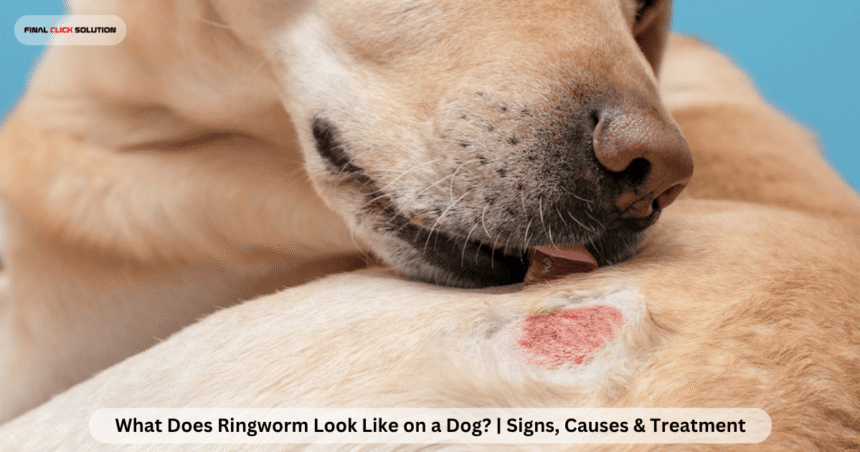Ringworm is a common fungal infection that affects dogs, causing concern for pet owners who want to ensure their furry friends stay healthy. Despite its name, ringworm is not caused by a worm but by a group of fungi called dermatophytes. If you’re wondering, “What does ringworm look like on a dog?” this comprehensive guide will walk you through the signs, symptoms, causes, and treatment options for ringworm on a dog. Understanding what does a ringworm look like on a dog is crucial for early detection and effective management, ensuring your pet’s comfort and preventing the spread of this contagious condition.
Understanding Ringworm in Dogs
Ringworm, medically known as dermatophytosis, is a skin infection caused by fungi that thrive on the outer layers of a dog’s skin, hair, and nails. The most common species affecting dogs are Microsporum canis, Microsporum gypseum, and Trichophyton mentagrophytes. This condition is highly contagious and can spread to other pets, humans, and even household surfaces. Knowing what does ringworm on a dog look like is the first step in addressing this issue promptly.
Ringworm gets its name from the characteristic circular, ring-shaped lesions it often produces on the skin, though these lesions may not always be perfectly round. The infection is more common in puppies, senior dogs, or those with compromised immune systems, but any dog can be affected. Environmental factors like warm, humid climates or crowded living conditions can also increase the risk of ringworm on a dog.
What Does Ringworm Look Like on a Dog?
So, what does ringworm look like on a dog? The appearance of ringworm can vary depending on the dog’s coat, skin type, and the severity of the infection. Here are the key signs to look for when identifying ringworm on a dog:
- Circular Patches of Hair Loss: One of the most recognizable signs of ringworm on a dog is circular areas of hair loss, often with a red, scaly, or crusty border. These patches may appear inflamed and can sometimes have a grayish or ashy center. The classic “ring” shape is a hallmark, but not all cases present this way.
- Red, Scaly, or Crusty Skin: The affected areas may look red, irritated, or scaly. In some cases, the skin may appear crusty or have small pustules. These symptoms are often accompanied by mild to moderate itching, though some dogs may not scratch at all.
- Brittle or Broken Hairs: Ringworm can cause hair to become brittle, leading to broken or stubbly hairs in the affected area. This is particularly noticeable in short-haired breeds, where the skin changes are more visible.
- Spreading Lesions: If left untreated, ringworm on a dog can spread to other parts of the body, such as the legs, face, ears, or tail. The lesions may merge, creating larger patches of affected skin.
- Nail Infections: In rare cases, ringworm can affect a dog’s nails, causing them to become brittle, discolored, or deformed. This is less common but can occur in severe infections.
If you’re asking, “What does a ringworm look like on a dog?” these symptoms are the primary indicators. However, because ringworm can resemble other skin conditions like allergies, mange, or bacterial infections, it’s essential to consult a veterinarian for an accurate diagnosis.
Causes of Ringworm in Dogs
Understanding what causes ringworm is key to preventing it. The fungi responsible for ringworm thrive in warm, moist environments and can be transmitted through:
- Direct Contact: Dogs can contract ringworm by touching an infected animal, such as another dog, cat, or even a human.
- Contaminated Objects: Bedding, grooming tools, toys, or surfaces that carry fungal spores can spread ringworm to a dog.
- Environmental Exposure: Soil or outdoor areas contaminated with dermatophytes can also be a source of infection, especially for dogs that dig or play in dirt.
Puppies, elderly dogs, or those with weakened immune systems are more susceptible to ringworm on a dog. Stress, poor nutrition, or underlying health conditions can also increase the risk.
Diagnosing Ringworm in Dogs
If you suspect ringworm on a dog, a veterinarian will use several methods to confirm the diagnosis. These may include:
- Wood’s Lamp Examination: Some strains of ringworm, particularly Microsporum canis, fluoresce under a special ultraviolet light called a Wood’s lamp. However, not all cases glow, so this test isn’t foolproof.
- Fungal Culture: The vet may take a sample of hair or skin from the affected area and culture it to identify the specific fungus.
- Microscopic Examination: Skin scrapings or hair samples may be examined under a microscope to detect fungal spores.
- Biopsy: In rare cases, a skin biopsy may be necessary to confirm the diagnosis.
If you’re wondering, “What does ringworm look like on a dog?” but aren’t sure if that’s what your pet has, a vet visit is critical to rule out other conditions with similar symptoms.
Treatment Options for Ringworm on a Dog
Treating ringworm on a dog requires a combination of topical and oral therapies, along with environmental management to prevent reinfection. Here’s what you can expect:
- Topical Treatments: Antifungal shampoos, creams, or ointments containing ingredients like miconazole, clotrimazole, or terbinafine are commonly prescribed. These are applied directly to the affected areas to kill the fungus and soothe the skin.
- Oral Medications: In more severe cases, oral antifungal drugs like itraconazole, fluconazole, or griseofulvin may be prescribed. These medications are typically given for several weeks to ensure the infection is fully eradicated.
- Environmental Decontamination: Since ringworm spores can survive in the environment for months, thorough cleaning is essential. Wash bedding, toys, and grooming tools with hot water and disinfectant. Vacuum carpets and furniture regularly, and consider using a pet-safe antifungal spray on surfaces.
- Isolation: If you have multiple pets, isolate the infected dog to prevent the spread of ringworm to other animals or humans.
Treatment can take several weeks to months, depending on the severity of the infection. Regular follow-ups with your vet are crucial to monitor progress and ensure the infection is fully resolved.
Preventing Ringworm in Dogs
Preventing ringworm on a dog involves reducing exposure to the fungus and maintaining your pet’s overall health. Here are some tips:
- Regular Grooming: Keep your dog’s coat clean and well-groomed to reduce the risk of fungal infections.
- Clean Environment: Regularly clean and disinfect your dog’s bedding, toys, and living areas.
- Avoid Contact with Infected Animals: Limit your dog’s interaction with stray animals or those known to have ringworm.
- Boost Immunity: Feed your dog a balanced diet and ensure regular vet checkups to keep their immune system strong.
By staying proactive, you can minimize the chances of your dog developing ringworm and keep their skin healthy.
Can Ringworm Spread to Humans?
Yes, ringworm is zoonotic, meaning it can spread from dogs to humans. If you notice symptoms like red, itchy, circular patches on your skin after handling an infected dog, consult a doctor. To reduce the risk of transmission, wear gloves when applying topical treatments to your dog, wash your hands thoroughly, and avoid direct contact with the affected areas.
When to See a Veterinarian
If you suspect ringworm on a dog or are asking, “What does a ringworm look like on a dog?” don’t delay in seeking veterinary care. Early diagnosis and treatment can prevent the infection from spreading and reduce discomfort for your pet. Look for signs like hair loss, red or scaly skin, or unusual scratching, and contact your vet for guidance.
Conclusion
Knowing what does ringworm look like on a dog is essential for every pet owner. By recognizing the telltale signs, circular patches of hair loss, red or scaly skin, and brittle hairs, you can take swift action to address ringworm on a dog. With proper treatment, including topical and oral therapies, and thorough environmental cleaning, your dog can recover fully from this fungal infection. If you’re ever unsure about what does a ringworm look like on a dog, consult your veterinarian for an accurate diagnosis and tailored treatment plan. By staying vigilant and proactive, you can keep your dog healthy, happy, and free from ringworm.








